Czech Republic
Template:Infobox State/Maintenance/NAME-German
The Czech Republic (Czech Česko, officially Czech Republic, Czech Česká republika ![]() ) is a landlocked country in Central Europe with about 10.5 million inhabitants. It is composed of the historical lands of Bohemia (Čechy) and Moravia (Morava) and parts of Silesia (Slezsko). The country borders Germany to the west, Poland to the north, Slovakia to the east and Austria to the south. The capital and metropolis of the country is Prague (Czech: Praha), other major cities are Brno, Ostrava, Plzeň, Liberec and Olomouc.
) is a landlocked country in Central Europe with about 10.5 million inhabitants. It is composed of the historical lands of Bohemia (Čechy) and Moravia (Morava) and parts of Silesia (Slezsko). The country borders Germany to the west, Poland to the north, Slovakia to the east and Austria to the south. The capital and metropolis of the country is Prague (Czech: Praha), other major cities are Brno, Ostrava, Plzeň, Liberec and Olomouc.
In the 6th century Slavs migrated into Bohemia, which had previously been settled by Celts and Germanic tribes. At the beginning of the 9th century, the Moravian Empire was formed as the first Slavic state. The unified Czech state emerged under the Bohemian Přemyslid dynasty when the Margraviate of Moravia was subordinated to Bohemia in the 11th century and the Kingdom of Bohemia was formed in 1085. It held a special position in the Holy Roman Empire and ruled large areas of continental Europe under the Přemyslids and Luxemburgs. During the rise of the Habsburgs and the Thirty Years' War, the area became part of the Habsburg Monarchy and remained so until its disintegration after defeat in the First World War.
In 1918, the democratic Czechoslovakia was founded. In 1939, the Czech part of the country was occupied by Nazi Germany and declared the Protectorate of Bohemia and Moravia. In 1945 the Allies, with the support of the Czechoslovak Exile Army, liberated the country from the Nazi regime. After the war, the German minority was expelled. After the Red Army occupied most of Czechoslovakia, the Communist Party (KSČ) took power in the country in 1948 in the so-called February coup, which thus became a satellite state of the Soviet Union. Warsaw Pact troops put down the Prague Spring reform movement in 1968. After the Velvet Revolution in 1989, democracy was re-established under President Václav Havel. Today's Czech Republic came into being on 1 January 1993 with the peaceful partition of Czechoslovakia. It has been a member of NATO since 1999 and a member of the European Union since 2004.
The Czech Republic is an industrialized country. Its gross domestic product per capita is the highest of the former CMEA members. In the Human Development Index, the country ranked 26th in the world in 2019. In terms of both political and economic transformation, the Czech Republic occupies top positions.
Geography
The Czech Republic borders Germany (810.3 km) to the west and northwest, Poland (762 km) to the northeast, Slovakia (252 km) to the southeast, and Austria (466 km) to the south. The landlocked country is roughly equidistant from the Baltic Sea and the Adriatic Sea. The west-east extent of the Czech Republic is a maximum of 493 kilometres, the north-south extent 278 kilometres. Of the total area of 78,866 square kilometres, 67 % is flat and hilly land up to 500 m above sea level, 32 % is between 500 and 1000 m and about 1 % is above that. The share of water area is 3 %. The lowest point of the Czech Republic is the Elbe near Hřensko (115 m), the highest mountain is the Schneekoppe (1603 m).
Geomorphology
The Czech Republic is surrounded by mountain ranges on its edges. That's why people in Upper Austria and the Upper Palatinate, for example, say "I'm going into Bohemia". On the south-western border of the Czech Republic lies the Šumava (1000 to 1400 metres), in the north-west the Krušné hory (1244 metres) and in the north the Krkonoše and Hrubý Jeseník. The eastern border with Slovakia is formed by the Beskydy and White Carpathians and the Morava River. Only the southern border with Lower Austria runs largely along a river - the strongly meandering Dyje.
The geomorphological division of the Czech Republic divides the country into two systems on the basis of mountain formation. The Bohemian Massif, which covers about three quarters of the area, belongs to the Central European Variscid. The Czech part of the Carpathians in the southeast belongs to the Alpine mountain system. The subprovinces are composed of basin landscapes surrounded and subdivided by mountains. The Bohemian-Moravian Highlands (600 to 800 metres) separate the Bohemian Basin from the South Moravian Lowlands. Rich in limestone caves is the Moravian Karst. Moravia shares the Carpathian foothills in the east and the Vienna Basin in the south.
See also: List of mountains and elevations in the Czech Republic
Waters
The main European watershed runs along the ridges of the Upper Palatinate and Bohemian Forests, the Bohemian-Moravian Highlands, the Beskids and the Western Carpathians.
- The Elbe (Labe) drains a large part of the Czech Republic into the North Sea. Its tributary, the Vltava, is the longest river on Czech territory at 433 kilometres.
- In Silesia the Oder (Odra) drains with the Opava into the Baltic Sea.
- The Morava drains southwards via the Danube into the Black Sea. Its largest tributary is the Dyje.
There are relatively few natural lakes in the Czech Republic, the largest being Černé jezero in Šumava. However, pond farming has been practiced since the 12th century. The largest system of fish ponds is located in Třeboňsko in South Bohemia. In the 20th century, the construction of dams created numerous artificial lakes for flood control, power generation, and recreation. The largest reservoirs can be found along the Vltava cascade.
See also: List of rivers in the Czech Republic
Climate
The Czech Republic is located in the temperate temperature zone of the Earth. The average annual temperature was around 8.1 °C in the years after 1951 and around 10.0 °C in the last years before 2018. It has therefore increased significantly during this time (→ Global warming).
Winters are relatively mild (February: 0.5 °C) and summers relatively cool (June: 18.6 °C). The annual precipitation in Prague was measured at 508 millimetres; a relatively low value due to its location in the lee of the Bohemian Forest, Upper Palatinate Forest and Ore Mountains.
Nature Conservation
→ Main article: List of nature reserves in the Czech Republic
There are four national parks in the Czech Republic. The largest, the Šumava National Park, together with adjacent protected areas, forms one of the most species-rich natural areas in Central Europe. The Krkonoše, Bohemian Switzerland and Thaya Valley National Parks also border on protected areas in neighbouring countries. In addition, the regions of Třeboňsko, Křivoklátsko, the White Carpathians and the Lower Marchtal are designated as biosphere reserves. The 26 protected landscape areas are large-scale natural landscapes, the 109 national nature reserves are small-scale strictly protected unique ecosystems. The Czech Republic lies on the European Green Belt.
Recently, a return of larger wild animals can be observed. In the Bohemian Forest, lynxes and elks live again. Especially in the Carpathian region, passing wolves and brown bears are observed. Wolf packs have settled around Lake Mácha as well as around Broumov since 2014.
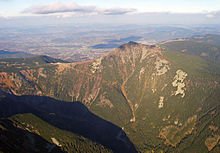
The Schneekoppe is the highest elevation in the Czech Republic
_-_by_Pudelek.jpg)
The Prebisch Gate in the Elbe Sandstone Mountains
,_Třeboň.jpg)
The South Bohemian Rosenberg Pond in Autumn

River system of the Czech Republic with the 25 largest reservoirs
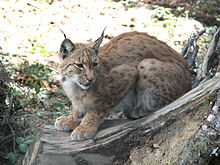
The lynx returned to the Bohemian Forest
Population
On 10 April 2014, the Czech Republic had a population of 10,517,400. In the 2011 census, Czechs formed the largest group with 64.3 percent, followed by Moravians with 5.0 percent and Slovaks with Czech citizenship with 1.4 percent. Czechs and Moravians were not recorded separately until 1991. The indication of Moravian nationality in the census tends to be understood as an expression of Moravian patriotism. In 1991, for example, 13.2 percent of the population stated that they were Moravian in the first census. In the 2001 census, 0.1 percent of the population stated that they were Silesian (in 1991, 0.4 percent).
The trend is downward for almost all ethnic minorities. Thus, in the same ten years, the number of Poles (officially counted) - especially residing in the Teschen region - decreased from 59,383 (0.6%) to 51,968 (0.5%), and that of Germans (excluding German citizens with right of residence, but including Germans with dual citizenship) from 48,556 (0.5%) to 39,106 (0.4%).
The actual proportion of Roma in the population is probably much higher than indicated in this census. There are thought to be around 250,000 to 300,000 Roma in the Czech Republic, which would be about three percent of the total population. Many Roma live in the country's peripheral areas and in socially weaker metropolitan neighbourhoods. For various reasons (weak national consciousness, discrimination, identification as Czechs), many of their members tend to declare a different ethnicity in censuses.
The number of foreigners has risen steadily since 2000 and more than doubled to 410,000 within nine years until 2008. As of 31 December 2016, there were 493,441 foreigners living in the Czech Republic. This represents 4.66 per cent of the population, a figure that is still well below the EU-wide average despite the sharp increase. Among foreign citizens, Ukrainians with 107,418 and Slovaks with 107,251 form the largest groups. They are followed by Vietnamese living in the Czech Republic with 57,650, Russians with 33,970, Germans with 21,216 and Poles with 20,305. The total number of EU foreigners is 208,166. In 2017, 4.1% of the population were migrants.
Development
| Year | Population | Year | Population |
| 1950 | 8.903.000 | 1990 | 10.341.000 |
| 1955 | 9.362.000 | 1995 | 10.358.000 |
| 1960 | 9.590.000 | 2000 | 10.290.000 |
| 1965 | 9.811.000 | 2005 | 10.258.000 |
| 1970 | 9.818.000 | 2010 | 10.536.000 |
| 1975 | 10.070.000 | 2015 | 10.604.000 |
| 1980 | 10.349.000 | 2030 | 10.528.000 |
| 1985 | 10.331.000 | 2050 | 10.054.000 |
Source: UN, values for 2030 and 2050 are forecasts
Religions
The Czech Republic is often portrayed as a particularly atheistic country in Europe. Although the three censuses after the fall of communism in 1989 show a dramatic decline in membership of the traditional Christian churches, it is not atheism that has increased, but a particular form of individualised religiosity, as well as religious apathy. Moreover, historical trends and more recent surveys reveal significant regional differences. According to formal, institutional religious affiliation, 71 % of the Czech population does not belong to any religious community. This is the highest figure in Europe, ahead of the United Kingdom (50.6%) and France (50.5%). 27.1% declare themselves to be Christians. According to the 2011 census, 10.3% are Roman Catholic and 0.9% are Protestant (including: Czechoslovak Hussite Church, Silesian Evangelical Church A.B., Evangelical Church of Czech Brethren, and Union of Czech Baptists); 3.2 percent belong to other religious groups, including about 15,000 Jehovah's Witnesses, 7000 Buddhists, 5000 Czech Jews, and about 10,000 Muslims. However, 45.2 per cent of the population do not state their religious affiliation and a further 6.7 per cent answered that they are believers without belonging to a particular denomination. The Orthodox Church of the Czech Lands and Slovakia is a special case, as it still forms a binational religious community after the dissolution of Czechoslovakia. Of the total of 77,053 Orthodox Czechs and Slovaks, 23,053 Czechs professed this denomination in 2001.
An important holiday for Christians is July 5, which commemorates the arrival of the Slavic apostles Cyril and Methodius in Great Moravia in 862. In addition to the national saint Wenceslas, the saints Ludmilla, Adalbert and Agnes are venerated. The reformer Jan Hus has a high significance in the Czech self-image.
The majority of the churches' property expropriated after the Second World War has been gradually restituted since 2013. In return, subsidies to the churches are being reduced.
According to a representative survey by Eurobarometer, 19% of people in the Czech Republic believed in God in 2005, 50% believed somewhat more vaguely in a spiritual force. 30% percent of respondents believed neither in a God nor in another spiritual force, 1% of Czechs were undecided.
Statistics
Around 75 percent of the Czech Republic's inhabitants live in cities. Life expectancy in 2015 was 78.2 years (men: 75.1 years, women: 81.2 years). The group of 0- to 14-year-olds includes 15.0 per cent, the group of 15- to 64-year-olds 66.5 per cent and the over-65s 18.5 per cent. The population growth rate in 2015 was 0.1 percent, and the fertility rate was 1.5 births per woman.
The majority of Czechs live in their own properties: in 2008, around 40 percent of households in the Czech Republic lived in their own house and 20 percent in their own apartment. 23 percent lived for rent, and another 12 percent lived in cooperative apartments. In 1995, only 2 per cent lived in their own flat, but by 2005 the figure had risen to 18 per cent. In the same period, the share of households living in rented accommodation fell from 40 to 25 per cent.
Largest cities
| City | Region | Inhabitants1 | Inhabitants30 |
| Praha (Prague) | hl.m.Praha (capital city of Prague) | 1.169.106 | 1.249.026 |
| Brno (Brünn) | Jihomoravský (South Moravia) | 376.172 | 371.399 |
| Ostrava (Ostrava) | Moravskoslezský (Moravian-Silesian) | 316.744 | 306.006 |
| Plzeň (Pilsen) | Plzeňský (Pilsen) | 165.259 | 169.935 |
| Liberec (Reichenberg) | Liberecký (Reichenberg) | 99.102 | 101.625 |
| Olomouc (Olomouc) | Olomoucký (Olomouc) | 102.607 | 100.362 |
| Ústí nad Labem (Aussig on the Elbe) | Ústecký (Aussig) | 95.436 | 95.477 |
| České Budějovice (Budweis) | Jihočeský (South Bohemia) | 97.339 | 94.865 |
| Hradec Králové (King's Hradec) | Královéhradecký (King's Hradec) | 97.155 | 94.493 |
| Pardubice (Pardubice) | Pardubický (Pardubice) | 90.668 | 90.778 |
| Havířov | Moravskoslezský (Moravian-Silesian) | 85.855 | 82.896 |
| Zlín (Zlin) | Zlínský (Zlin) | 80.854 | 75.714 |
| Kladno (Kladen) | Středočeský (Central Bohemia) | 71.132 | 69.938 |
| Most (Brüx) | Ústecký (Aussig) | 68.263 | 67.518 |
| Karviná (Karwin) | Moravskoslezský (Moravian-Silesian) | 65.141 | 61.948 |
| Frýdek-Místek (Friedeck-Mistek) | Moravskoslezský (Moravian-Silesian) | 61.400 | 58.582 |
| Opava (Troppau) | Moravskoslezský (Moravian-Silesian) | 61.382 | 58.440 |
| Děčín (Tetschen) | Ústecký (Aussig) | 52.506 | 52.260 |
| Karlovy Vary (Carlsbad) | Karlovarský (Carlsbad) | 53.358 | 51.320 |
| Jihlava (Iglau) | Vysočina (Highlands) | 50.702 | 51.222 |
| Teplice | Ústecký (Aussig) | 51.060 | 51.208 |
| Chomutov (Komotau) | Ústecký (Aussig) | 51.007 | 49.795 |
| Přerov (Prerau) | Olomoucký (Olomouc) | 48.335 | 46.254 |
| Jablonec nad Nisou (Gablonz on the Neisse) | Liberecký (Reichenberg) | 45.266 | 45.328 |
| Prostějov (Proßnitz in Moravia) | Olomoucký (Olomouc) | 48.159 | 45.324 |
See also: List of cities in the Czech Republic
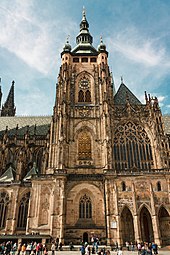
St. Vitus Cathedral at Prague Castle is the cathedral of the Archbishopric of Prague
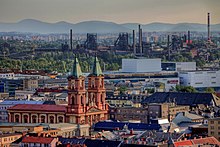
Ostrava Cathedral and industrial facilities

The Cathedral of St. Peter and Paul in Brno
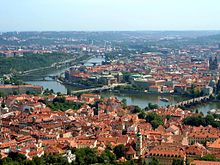
The capital Prague on the Vltava

Proportion of those who describe themselves as "believers" (2011)

Population pyramid Czech Republic 2016
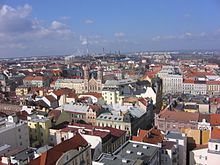
View over the roofs of Pilsen
Questions and Answers
Q: What is the official long name of Czechia?
A: The official long name of Czechia is the Czech Republic.
Q: What is the capital city of Czechia?
A: The capital city of Czechia is Prague.
Q: What currency does Czechia use?
A: The currency used in Czechia is the Czech Crown (koruna česká - CZK).
Q: Who is the president of Czechia?
A: The president of Czechia is Miloš Zeman.
Q: How many people live in Czechia?
A: Approximately 10.5 million people live in Czechia.
Q: What language do people speak in Czechia?
A: People in Czechia speak the local language, which is a Slavic language related to languages like Slovak and Polish.
Q: Which countries border withCzech Republic? A:The countries that border withCzech Republic are Germany, Austria, Slovakia, and Poland.
Search within the encyclopedia